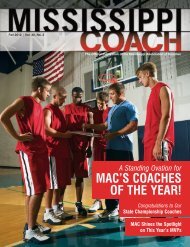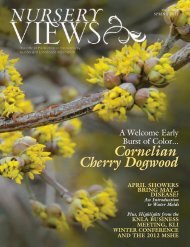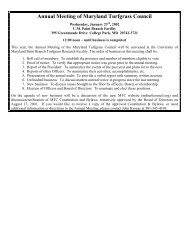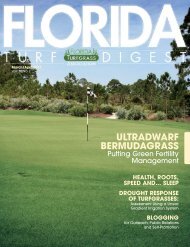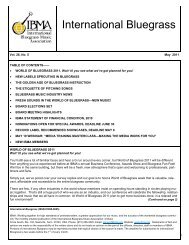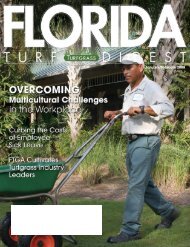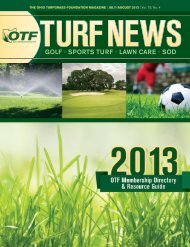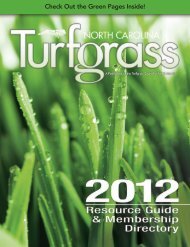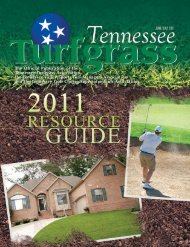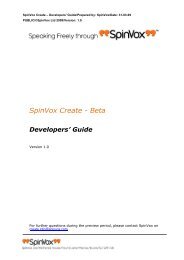Cover StoryBy David McCall, Research Specialist, Dept. of Plant Pathology, <strong>Virginia</strong> TechForyears, weseemedto knoweverything there was to knowabout ergosterol biosynthesisinhibitors, or more commonlyknown as demethylation inhibitors(DMIs). Propiconazole (Banner),triadimefon (Bayleton) andmyclobutanil (Eagle) were staplesof most turf managers’ fungicidearsenal. Fenerimol (Rubigan)certainly had its place in themarket, and people were relativelycomfortable with its uses andlimitations. Turf managers hadused these products repeatedlyover the years, and they knewwhat to expect. Not much reallychanged for well over a decade.Over the last three years, however,the turf market has seen thelaunch of three new active ingredientsin this class: metconazole(Tourney), tebuconazole (Torque,Quali Pro Tebuconazole) andtriticonazole (Trinity and Triton).Along with a new set of productscomes a new set of questions.Will disease control be the same?Will growth regulation still occur?Can these products be used inrotation with the older DMIs?Can plant growth regulators stillbe applied in conjunction withthese products?While all of these DMIs havesome similarities, each producthas unique advantages and disadvantages.For instance, most of thenewer DMIs have increased activityagainst anthracnose and brownpatch, compared with some of theolder chemistries, but they oftenlag behind in controlling dollarspot. As with the older generationof DMIs, the newest additionspose some potential for someturf injury. Injury and/or growthregulation is most frequentlyobserved on golf course puttinggreens, but it is seldom a problemon higher-cut turfgrasses.Generally speaking, the newgeneration is considered to besafer, with reduced risk of anyobjectionable injury. I have seen12| VIRGINIA TURFGRASS JOURNAL January/February 2012 www.vaturf.org
examples of each product, however,that have given cause forconcern. In each of these cases, Ifeel that injury could have beenprevented if handled differently.I have noted mild injury frommetconazole and triticonazolefollowing multiple (3+) continuousapplications at high labeledrates (and above) on bi-weeklyintervals during the summer. Thisshould not be a common practicefor turf managers, but it was donein the interest of research (I getto do dumb things with productsto test the limits!).I have also seen rare cases wheretebuconazole caused significantinjury to annual bluegrass. Inthese situations, the product waseither applied above the labelrate (currently, 0.6 fl. oz./1,000ft 2 is the only labeled rate) or inconjunction with another productthat caused stress to the turf.DMI applied at 2 gal./1,000 ft 2Aug. 24, 2011. <strong>Virginia</strong> Tech G.C.Banner Maxx(propiconazole)Bayleton SC(triadimefon)Eagle EW(myclobutanil)QP Tebuonazole(tebuonazole)Tourney(metconazole)Trinity(triticonazole)Triton Flo(triticonazole)Figure 1. Comparison of DMI fungicides on annual bluegrass putting greens, usingsimple ratio vegetative index (RVI). RVI utilizes reflectance values from visible red andnear-infrared spectral regions. Higher RVI values correlate to greater turf health. Lowand high rates for each DMI as formulated product per 1,000 ft 2 : Banner Maxx (1, 2),Bayleton SC (0.5, 1), Eagle EW (0.6, 1.2), QP Tebuconazole (0.6 only labeled rate),Tourney (0.28, 0.37), Trinity (0.5, 1) and Triton Flo (0.22, 1.1).Optimizing performanceResistance management is an importantissue when dealing with DMIfungicides. There are confirmedcases of resistance to dollar spot,anthracnose and gray leaf spot.While the next generation DMIsare new to the market, they are stillDMIs. So, rotating from propiconazoleto, say, metconazole is nottruly a rotation, and it could potentiallyincrease the likelihood ofdeveloping resistance.Frequently, when control isshort lived, turf managers ask meif they have dollar spot resistanceto this group. While resistance todollar spot is highly possible, themost common reasons for failureare improper spray volume or nozzleselection. As mentioned above,another option is that the activeingredient being used just isn’tas effective as others. The newerDMIs typically aren’t as effective aspropiconazole or triadimefon forcontrolling dollar spot.Spray volume with the DMIsshould be somewhere between 1and 2 gallons per 1,000 ft 2 (44–88GPA). Flood-type nozzles typicallydo not provide adequate coverage,even though these products moveupward within the plant (acropetally).We recommend usingsome sort of flat-fan nozzle withmoderate drift potential, such asthe Turbo TeeJet Induction (TTI)nozzles from Spraying Systems.These types of nozzles provide agood blend of adequate uniformcoverage and reduced drift.Finally, the most importantmeans for optimizing performanceis by making sound cultural decisionsthat will increase turf healthand reduce likelihood of severedisease outbreaks.Product pros and consAs mentioned above, there arepros and cons to each of the DMIs.Each is briefly summarized below.PropiconazoleFor years, propiconazole has beenone of the most consistent andreliable dollar spot products on themarket. Depending on the applicationrate, it is not uncommon toexpect 21 days or better for controllingdollar spot, even duringpeak disease season. It is also agood option for numerous otherdiseases. Compared with otherDMIs, propiconazole is typicallyweaker at controlling brown patchand anthracnose, although someactivity should be expected.One of the additional featuresof propiconazole is its growth regulationof several turfgrasses. Inmost situations, this regulationresults in darker-green colorationand overall improved quality. Ongolf putting greens, regulationduring the summertime has oftenbeen described as making greensappear both faster and droughtstressed. Some find this highlydesirable, while others find itobjectionable.One side effect of growth regulationon greens is an increasedlikelihood of algae encroachmentdue to a more open canopy. Thiscan easily be remedied by tank mixingwith a contact fungicide, suchas chlorothalonil or mancozeb.Journal of the <strong>Virginia</strong> <strong>Turfgrass</strong> <strong>Council</strong> | 13




